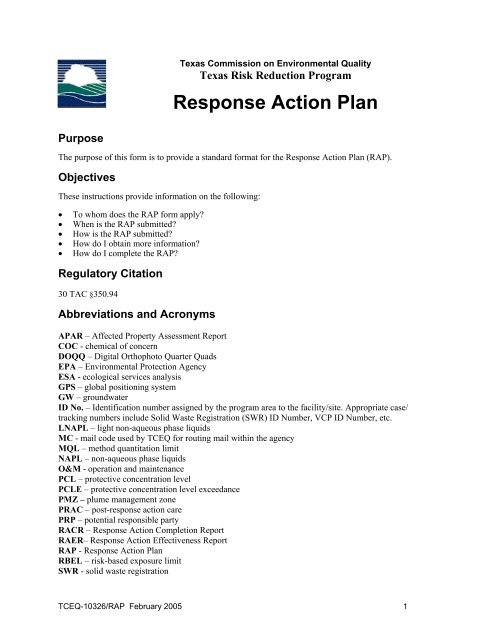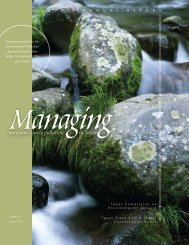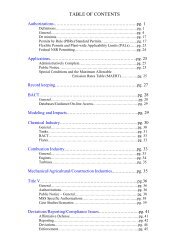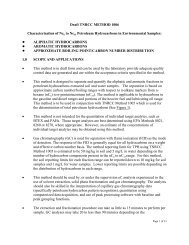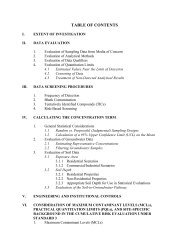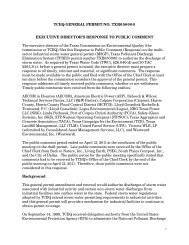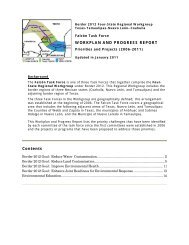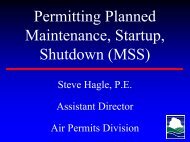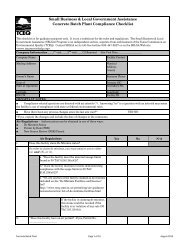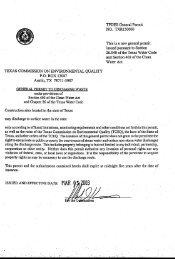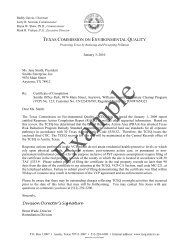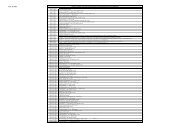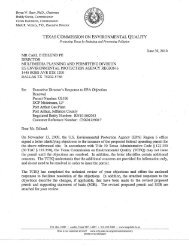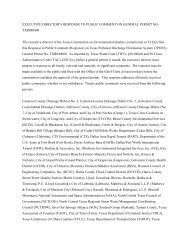Response Action Plan - TCEQ e-Services
Response Action Plan - TCEQ e-Services
Response Action Plan - TCEQ e-Services
Create successful ePaper yourself
Turn your PDF publications into a flip-book with our unique Google optimized e-Paper software.
Texas Commission on Environmental Quality<br />
Texas Risk Reduction Program<br />
<strong>Response</strong> <strong>Action</strong> <strong>Plan</strong><br />
Purpose<br />
The purpose of this form is to provide a standard format for the <strong>Response</strong> <strong>Action</strong> <strong>Plan</strong> (RAP).<br />
Objectives<br />
These instructions provide information on the following:<br />
• To whom does the RAP form apply?<br />
• When is the RAP submitted?<br />
• How is the RAP submitted?<br />
• How do I obtain more information?<br />
• How do I complete the RAP?<br />
Regulatory Citation<br />
30 TAC §350.94<br />
Abbreviations and Acronyms<br />
APAR – Affected Property Assessment Report<br />
COC - chemical of concern<br />
DOQQ – Digital Orthophoto Quarter Quads<br />
EPA – Environmental Protection Agency<br />
ESA - ecological services analysis<br />
GPS – global positioning system<br />
GW – groundwater<br />
ID No. – Identification number assigned by the program area to the facility/site. Appropriate case/<br />
tracking numbers include Solid Waste Registration (SWR) ID Number, VCP ID Number, etc.<br />
LNAPL – light non-aqueous phase liquids<br />
MC - mail code used by <strong>TCEQ</strong> for routing mail within the agency<br />
MQL – method quantitation limit<br />
NAPL – non-aqueous phase liquids<br />
O&M - operation and maintenance<br />
PCL – protective concentration level<br />
PCLE – protective concentration level exceedance<br />
PMZ – plume management zone<br />
PRAC – post-response action care<br />
PRP – potential responsible party<br />
RACR – <strong>Response</strong> <strong>Action</strong> Completion Report<br />
RAER– <strong>Response</strong> <strong>Action</strong> Effectiveness Report<br />
RAP - <strong>Response</strong> <strong>Action</strong> <strong>Plan</strong><br />
RBEL – risk-based exposure limit<br />
SWR - solid waste registration<br />
<strong>TCEQ</strong>-10326/RAP February 2005 1
TAC - Texas Administrative Code<br />
<strong>TCEQ</strong> – Texas Commission on Environmental Quality<br />
TI – technical impracticability<br />
TRRP – Texas Risk Reduction Program<br />
VCP – Voluntary Cleanup Program<br />
WCU – waste control unit<br />
General Instructions<br />
Read these instructions carefully because the form itself does not contain all the instructions. You cannot<br />
adequately complete the RAP without following these instructions. The RAP is not a guidance document.<br />
You must consult the TRRP rule and associated guidance documents to develop your RAP.<br />
To whom does the RAP form apply?<br />
The RAP is submitted by persons who will be conducting response actions under the Texas Risk<br />
Reduction Program (TRRP) rule to attain Remedy Standard B or for those persons who choose not to<br />
self-implement response actions to attain Remedy Standard A.<br />
When is the RAP submitted?<br />
Submit the RAP to the <strong>TCEQ</strong> for review and approval prior to commencing response actions to attain<br />
Remedy Standard B or non-self-implementing Remedy Standard A. This does not preclude the person<br />
from taking interim measures. Submit the APAR with the RAP unless the APAR was submitted<br />
previously. If the APAR was previously submitted and additional data has been collected since that time,<br />
include an amended APAR with the RAP if the APAR worksheets are needed to convey the information,<br />
or include the data in the RAP.<br />
How is the RAP submitted?<br />
Submit a copy of this form to both the applicable <strong>TCEQ</strong> program area in the Austin Central Office and to<br />
the appropriate <strong>TCEQ</strong> Region Office. The mailing address and phone number for each of the Regional<br />
Offices may be found at http://www.tceq.state.tx.us/AC/about/directory/region/reglist.html. The address<br />
for the Central Office is:<br />
<strong>TCEQ</strong><br />
[specify program area], MC-<br />
P.O. Box 13087<br />
Austin, Texas 78711-3087<br />
How do I obtain more information?<br />
The TRRP rule and guidance are available at http://www.tnrcc.state.tx.us/permitting/trrp.htm. You will<br />
have to use the rule and associated guidance to complete your RAP. Questions regarding your affected<br />
property should be addressed to the program area that is handling your case. Phone numbers for the<br />
<strong>TCEQ</strong> programs are listed below.<br />
Voluntary Cleanup Section 512/239-2478 Corrective <strong>Action</strong> Section 512/239-2276<br />
Superfund Cleanup Section 512/239-2486 Municipal Solid Waste Permits 512/239-6784<br />
RPR Section 512/239-2200<br />
<strong>TCEQ</strong>-10326/RAP February 2005 2
How do I complete the RAP?<br />
Carefully review these instructions and all instructions on the worksheets themselves. Failure to complete<br />
the report as indicated may result in return of your report or a notice of deficiencies. Note that except<br />
for expanding the narrative boxes with text, the form must not be modified in any way. Do not<br />
change the numbering or the order of submittal of the worksheets, attachments, and appendices<br />
even when portions are not included. When possible, please print the report on both sides of the pages.<br />
Be sure to always include appropriate units of measurement in your answers.<br />
All data must be supported with references and documentation. Unsubstantiated information may<br />
be considered invalid.<br />
The form is designed so that only the relevant worksheets are submitted depending on the site-specific<br />
conditions and the components of the response action. Complete only the portions applicable to your<br />
RAP. Complete the Checklist for Report Completeness to determine which sections are applicable for<br />
your report. Arrange the worksheets, attachments, and appendices as specified in the RAP Contents list<br />
below. Note that the form does not include many of the attachments and appendices because they do not<br />
have prescribed formats (for example, laboratory reports). Place tabs in your bound report to clearly<br />
identify each major section of the report as noted in the RAP Contents list on page 5.<br />
If the on-site property is covered under a permit, any permit requirements that conflict with the<br />
information in this document supercede this guidance.<br />
Worksheets, Attachments, and Appendices<br />
The following instructions are listed in order of the worksheets, attachments, and appendices as specified<br />
in the RAP Contents list. All pages should include the regulatory ID number assigned to the on-site<br />
property, the date of the report, and page numbers.<br />
Cover Page - Specify the regulatory ID number assigned by the program area to the on-site property.<br />
Appropriate ID numbers include Solid Waste Registration (SWR) ID Number, VCP ID number, or other<br />
assigned number. If you do not know your regulatory ID number, contact the appropriate program area to<br />
obtain that number before submitting this report. Specify the report date and indicate if this report is the<br />
initial RAP for this affected property or if it is a subsequent submittal. Identify the <strong>TCEQ</strong> Region in<br />
which the affected property is located. The list of region numbers is located at the end of the instructions.<br />
Check the appropriate box to indicate the specific <strong>TCEQ</strong> program to which the report is submitted. The<br />
<strong>TCEQ</strong> mailing address should include the appropriate <strong>TCEQ</strong> program and the corresponding mail code<br />
(MC). If the report is being submitted to more than one program area, mail the reports separately and<br />
address copies to each program with that program indicated on the cover page.<br />
On-Site Property Information<br />
Indicate the address of the on-site property (the area at which the assessment took place). Note that the<br />
physical address is not a P.O. Box or a rural route. Include the following information for the on-site<br />
property; example: 814 North 35 th Street West<br />
• street number (example: 814) Leave blank if none.<br />
• street predirectional - compass direction of the street address that occurs before the street name<br />
(example: North). Leave blank if none.<br />
• street name (example: 35 th ) Leave blank if none.<br />
<strong>TCEQ</strong>-10326/RAP February 2005 3
• street type (example: Street) Leave blank if none.<br />
• street postdirectional - compass direction of the street address that occurs after the street name<br />
(example: West). Leave blank if none.<br />
• city<br />
• county<br />
• county code (see list at end of instructions)<br />
• zip code<br />
Specify the nearest street intersection or location description. For example, a location description may be:<br />
“On FM 1055, 1 mile south of the intersection of FM 1055 and US Highway 57” or “On Main Street at<br />
the intersection of Main Street and Broad Street.”<br />
Specify the latitude and longitude near the center of the on-site property, either in terms of degrees,<br />
minutes, seconds or decimal degrees. Indicate the units used. Refer to the definition of on-site property<br />
in §350.4(a)(1). Horizontal positions collected using certified GPS units or by interpretation from 1-<br />
meter Digital Orthophoto Quarter Quads (DOQQs) must maintain a minimum level of accuracy of at least<br />
25 meters. Use of GPS equipment is strongly encouraged in the acquisition of coordinates for all<br />
locations tracked by the <strong>TCEQ</strong>. Refer to the <strong>TCEQ</strong> document Attribute Standards for <strong>TCEQ</strong> Geographic<br />
Locational Data and the <strong>TCEQ</strong> policies 8.11 and 8.12, available on the agency’s web page at<br />
http://www.tnrcc.state.tx.us/gis/gisplcy.html.<br />
Affected Off-Site Property Information<br />
Include the address information in the format specified above for any affected off-site property(ies). If<br />
there is more than one affected off-site property, attach additional pages to list the same information for<br />
all affected off-site properties.<br />
Contact Person for On-Site Property Information and Acknowledgement<br />
Provide the identity and address of the person undertaking the response action (not the consultant).<br />
Please refer to the definition of “person” in §350.4. The person should review the acknowledgement<br />
carefully and must sign and date this form. The consultant is not allowed to sign this form.<br />
Executive Summary – Use this section to summarize the major points of the report and provide<br />
background information about the affected property.<br />
Chronology – Attach a chronology, listed in chronological order beginning with the most recent activity,<br />
of events associated with the assessment, all previous abatement and assessment activities, and all other<br />
corrective actions conducted at the affected property. Include the date of actions taken and a brief<br />
description of all release abatement activities, assessment activities, and response actions conducted.<br />
Illustrate and label all locations of relevant information on the Affected Property map in Attachment 1A.<br />
List all references, including the date, title, and preparer of previously submitted reports, in the reference<br />
list in Appendix 1.<br />
Checklist for Report Completeness - Use this checklist to identify the applicable worksheets for your<br />
RAP and indicate which components are included in your report.<br />
<strong>TCEQ</strong>-10326/RAP February 2005 4
Worksheet 1.0<br />
Attachment 1A*<br />
Attachment 1B*<br />
Worksheet 2.0<br />
Attachment 2A*<br />
Attachment 2B*<br />
Attachment 2C*<br />
Worksheet 2.1<br />
Attachment 2D*<br />
Attachment 2E*<br />
Worksheet 2.2<br />
Attachment 2F*<br />
Worksheet 2.3<br />
Attachment 2G*<br />
Worksheet 2.4<br />
Worksheet 3.0<br />
Worksheet 3.1<br />
Attachment 3A*<br />
Worksheet 3.2<br />
Worksheet 4.0<br />
Attachment 4A*<br />
Worksheet 5.0<br />
Attachment 5A*<br />
Attachment 5B*<br />
Attachment 5C*<br />
Worksheet 6.0<br />
Appendix 1*<br />
Appendix 2*<br />
Appendix 3*<br />
Appendix 4*<br />
Appendix 5*<br />
Appendix 6*<br />
Appendix 7*<br />
Appendix 8*<br />
RAP Contents<br />
Cover Page<br />
Executive Summary<br />
Chronology<br />
Checklist for Report Completeness<br />
Section 1 <strong>Response</strong> <strong>Action</strong> Objectives<br />
<strong>Response</strong> <strong>Action</strong> Objectives<br />
Maps and Cross Sections<br />
Graphs of Concentrations versus Time<br />
Section 2 <strong>Response</strong> <strong>Action</strong> Design<br />
<strong>Response</strong> <strong>Action</strong> Design<br />
<strong>Response</strong> <strong>Action</strong> Diagrams and Component/Equipment Descriptions<br />
Proposed Well Design<br />
ESA and Compensatory Restoration <strong>Plan</strong><br />
Plume Management Zone<br />
Plume Management Zone Map<br />
Attenuation <strong>Action</strong> Levels Determination<br />
Waste Control Unit<br />
Map of Waste Control Unit<br />
Technical Impracticability<br />
Map of Technical Impracticability Area<br />
Institutional Controls<br />
Section 3 <strong>Response</strong> <strong>Action</strong> Performance<br />
Performance Measures and Potential Problems<br />
Monitoring and Sampling<br />
Map of Monitoring and Sampling Points<br />
Operation and Maintenance<br />
Section 4 Confirmation Sampling<br />
Confirmation Sampling <strong>Plan</strong><br />
Map of Confirmation Sampling Points<br />
Section 5 Post-<strong>Response</strong> <strong>Action</strong> Care<br />
Post-<strong>Response</strong> <strong>Action</strong> Care<br />
Map of Post-<strong>Response</strong> <strong>Action</strong> Care Monitoring and Sampling Points<br />
Post-<strong>Response</strong> <strong>Action</strong> Care Costs<br />
Small Business Affidavit<br />
Section 6 Implementation Schedule<br />
Implementation Schedule<br />
Appendices<br />
References<br />
Data Tables and Boring Logs<br />
Studies/tests documentation<br />
Proposed Institutional Controls<br />
Landowner Concurrence<br />
Sampling Procedures<br />
Statistical Methodology<br />
Split Media Approval<br />
*These items are not included in the form and are provided by the person.<br />
<strong>TCEQ</strong>-10326/RAP February 2005 5
SECTION 1 – <strong>Response</strong> <strong>Action</strong> Objectives<br />
Worksheet 1.0 <strong>Response</strong> <strong>Action</strong> Objectives – Use this worksheet to describe the objectives of the<br />
response action. For each environmental media (surface soil, subsurface soil, groundwater, surface water,<br />
sediment, or air) containing a PCLE zone, state the response objectives for the PCLE zone(s) and how the<br />
response action will meet the remedy standard objectives in the proposed reasonable time. Refer to Soil<br />
and Groundwater <strong>Response</strong> Objectives (RG-366/TRRP-29) for more information on response action<br />
objectives.<br />
Attachment 1A Maps and Cross Sections – Unless the most recent and current data was included in the<br />
APAR, provide the following to document the most current and recent data:<br />
Affected Property Map – Include a large-scale map that illustrates all aspects of the affected property.<br />
Indicate the affected property boundary (this is not the legal property boundary) as defined by the<br />
assessment levels and the overall PCLE zone as defined by the critical PCLs. Include legal property<br />
boundaries, buildings and other structures, adjacent roads, all potential source areas and known release<br />
areas, land uses, type of surface cover, subsurface utilities, surface drainage, surface water bodies, boring<br />
and monitor well locations, other sampling locations, cross-section lines, water supply wells, and any<br />
other potential receptors. Required legend information: north arrow, fractional and bar scales, map source<br />
and identification of all symbols used on the map.<br />
COC Concentration Maps - Provide affected property map(s) to visually present analytical data. The<br />
maps, typically one map per significant COC per media, drawn to scale, should illustrate all sampling<br />
points, COC concentrations, isoconcentration contours including a contour of the critical PCL to delineate<br />
the PCLE zone, sample depth intervals, and relevant surface and subsurface features. When there is<br />
sufficient time series data, also construct maps for significant COCs using previous sampling dates to<br />
illustrate PCLE zone changes over time. Required legend information: north arrow, fractional and bar<br />
scales, and identification of all symbols used on the map.<br />
Parameters Maps - Provide maps as necessary to effectively illustrate the distribution of geochemical<br />
and geotechnical parameters (such as fraction organic carbon and bulk density) when such information is<br />
collected. Illustrate on maps drawn to scale all sampling points, geochemical and geotechnical<br />
concentrations and values, isoconcentration contours as appropriate to accurately depict the data in each<br />
media, sample depth intervals, and relevant surface and subsurface features. Required legend<br />
information: north arrow, fractional and bar scales, and identification of all symbols used on the map.<br />
Groundwater Gradient Map - Provide a groundwater gradient map, drawn to scale, illustrating all<br />
monitoring wells, groundwater surface elevation in feet AMSL or BMSL, labeled groundwater elevation<br />
contours, and groundwater flow direction. If groundwater elevation data was collected at several times<br />
and the groundwater flow magnitude or direction has changed over time, submit a sufficient number of<br />
maps to illustrate these changes. Required legend information: north arrow, fractional and bar scales, and<br />
identification of all symbols used on the map.<br />
Cross Sections - If new data results in modification of data from that provided in the APAR, provide a<br />
minimum of two cross-sections perpendicular to each other through the source area and affected property.<br />
For sites with monitor wells, construct one cross section approximately parallel to the groundwater flow<br />
direction and one approximately perpendicular to flow direction. Illustrate site stratigraphy using the<br />
boring logs through the total depth of the borings/monitor wells or water well if used in the cross section.<br />
Indicate all groundwater-bearing units, lithologies, designated surface and subsurface soils, areas<br />
exceeding the assessment level and critical PCL (PCLE zones) for each media, including the location,<br />
depth, and extent of NAPL, static groundwater level, monitor well screened intervals, aquitards, migration<br />
<strong>TCEQ</strong>-10326/RAP February 2005 6
pathways, subsurface conduits and the compass directions of the cross sections. Required legend items:<br />
horizontal and vertical scales and identification of all symbols used in the cross section. Indicate the cross<br />
section lines on the affected property map. Additional cross sections may be submitted as needed to<br />
effectively portray subsurface conditions.<br />
Attachment 1B Graphs of Concentration versus Time – Provide graphs of concentration versus time for<br />
significant COCs in critical monitor wells or other media sampling points. The most recent and current<br />
data must be used in the graphs. If the most recent and current data was used to construct these graphs in<br />
the APAR, this attachment does not need to be repeated in the RAP.<br />
SECTION 2 – <strong>Response</strong> <strong>Action</strong> Design<br />
Worksheet 2.0 <strong>Response</strong> <strong>Action</strong> Design – Provide a detailed description of the response action design<br />
for each media. Complete a separate worksheet for each different response action.<br />
Attachment 2A <strong>Response</strong> <strong>Action</strong> Diagrams and Component/Equipment Descriptions – Illustrate in<br />
maps, drawings, and diagrams the design and layout of equipment and components. The plan should<br />
clearly show: the location of all key equipment; the location and coverage of any proposed physical<br />
control; the area in which the response action will occur; recovery, monitoring, or injection wells;<br />
buildings; surface cover types; and surface drainage. Include equipment manufacturers' documentation<br />
that identifies equipment construction and performance measurements. Required legend information for<br />
maps: north arrow, fractional and bar scales, map source and identification of all symbols used on the<br />
map.<br />
Attachment 2B Proposed Well Design – Illustrate the proposed design and placement of any proposed<br />
monitor wells, recovery wells, or injection wells using construction diagrams and a map of proposed<br />
locations. Required legend information for maps: north arrow, fractional and bar scales, map source and<br />
identification of all symbols used on the map.<br />
Attachment 2C Ecological <strong>Services</strong> Analysis and Compensatory Restoration <strong>Plan</strong> – Use this<br />
attachment to provide an ecological services analysis (ESA) and compensatory restoration plan if<br />
proposed as part of the response action. Guidance discussing ESAs and compensatory restoration is<br />
provided in Guidance for Conducting Ecological Risk Assessments in Texas, available on the <strong>TCEQ</strong> web<br />
page.<br />
Worksheet 2.1 Plume Management Zone – Complete this worksheet when a plume management zone is<br />
proposed as part of the response action. Refer to Soil and Groundwater <strong>Response</strong> Objectives (RG-<br />
366/TRRP-29) for more information on plume management zones.<br />
Attachment 2D PMZ Map - Provide a map that illustrates the area of the plume management zone, the<br />
attenuation monitoring points, alternate groundwater POEs, and the groundwater PCLE zone. Note all<br />
receptors within the PMZ and any potentially threatened receptors outside the PMZ. Illustrate major<br />
buildings, structures, roads, and other major site features. Required legend information: north arrow,<br />
fractional and bar scales, map source and identification of all symbols used on the map.<br />
Attachment 2E Attenuation <strong>Action</strong> Levels Determination – Provide in this attachment all equations,<br />
calculations, and other methods of determining the attenuation action levels for each attenuation<br />
monitoring point. Provide supporting documentation for the justification that the PMZ is appropriate in<br />
accordance with §350.33(f)(4).<br />
<strong>TCEQ</strong>-10326/RAP February 2005 7
Worksheet 2.2 Waste Control Unit – Use this worksheet to provide information on the waste control unit<br />
if proposed as part of the response action. Do not submit this worksheet if a waste control unit is not part<br />
of the response action plan. Refer to Soil and Groundwater <strong>Response</strong> Objectives (RG-366/TRRP-29) for<br />
more information on response action objectives.<br />
Attachment 2F Waste Control Unit Map – Include a map that illustrates the waste control unit, the<br />
groundwater flow direction, the groundwater PCLE zone, and all major site features. Required legend<br />
information: north arrow, fractional and bar scales, map source and identification of all symbols used on<br />
the map.<br />
Worksheet 2.3 Technical Impracticability – Use this worksheet to provide information on a technical<br />
impracticability demonstration. If a technical impracticability demonstrate is not proposed, do not submit<br />
this worksheet or Attachment 2G. Refer to Soil and Groundwater <strong>Response</strong> Objectives (RG-366/TRRP-<br />
29) for more information on response action objectives.<br />
Attachment 2G Technical Impracticability Map – Provide a map that illustrates the area of technical<br />
impracticability, the groundwater flow direction, the groundwater PCLE zone, and all major site features.<br />
Required legend information: north arrow, fractional and bar scales, map source and identification of all<br />
symbols used on the map.<br />
Worksheet 2.4 Institutional Controls – Complete this worksheet if an institutional control will be used<br />
as part of the response action. Repeat this worksheet for each property that requires an institutional<br />
control. Refer to Institutional Controls (RG-366/TRRP-16) for further information on institutional<br />
controls.<br />
Section 3 <strong>Response</strong> <strong>Action</strong> Performance<br />
Worksheet 3.0 Performance Measures and Potential Problems – Describe the performance measures<br />
that will be used to determine if reasonable progress is being made by the response action. The<br />
performance measures must clearly demonstrate that the response actions addressing each media are<br />
being accomplished in a reasonable time. If statistical or geostatistical methods will be used as part of the<br />
effectiveness measures, discuss the assumptions and provide the equations for statistical or geostatistical<br />
methodology(ies) in Appendix 7. The results of the measures of effectiveness will be reported in the<br />
RAER and RACR to document that the response action is proceeding in a timely manner.<br />
Describe any potential problems that may occur with, or during, the response action. The description<br />
should demonstrate that potential problems have been anticipated and that contingency measures are in<br />
place. List potential problem that might be reasonably anticipated for a response action of this type, and<br />
that might result in response action failure and/or downtime. Describe the impact of the problem on the<br />
response action, and describe how the risk of each scenario will be minimized through duplicate systems,<br />
inspection and maintenance, preventive maintenance/parts replacements, and operational guidelines.<br />
Also describe the training, equipment, and assets that will be utilized in a timely manner for each<br />
response to a problem.<br />
Worksheet 3.1 Monitoring and Sampling – Specify the monitoring and sampling that will be conducted<br />
to assess the effectiveness and progression of the response action. Discuss the sampling methods in<br />
Appendix 6 unless the planned monitoring or sampling procedure is the same as the media sampling<br />
procedures described in the APAR.<br />
<strong>TCEQ</strong>-10326/RAP February 2005 8
Attachment 3A Map of Monitoring and Sampling Points – Provide maps showing the monitoring and<br />
sampling points in each media, the PCLE zone, and all major features of the site. Required legend<br />
information: north arrow, fractional and bar scales, map source and identification of all symbols used on<br />
the map.<br />
Worksheet 3.2 Operation and Maintenance –Provide a brief overview of the operation and maintenance<br />
activities. List the key operating parameters considered important to the proper operation of the response<br />
action and critical to its effectiveness. Provide the detail necessary to explain how the person will know<br />
the response action is functioning properly. List routine tasks required to operate and maintain the<br />
response action, including scheduled inspections, maintenance, and component replacement.<br />
SECTION 4 – Confirmation Sampling<br />
Worksheet 4.0 Confirmation Sampling <strong>Plan</strong> – Specify the COC or other parameter sampling that will be<br />
conducted in each media requiring a response action to confirm completion of the response action.<br />
Discuss the sampling methods in Appendix 6 unless the methods are the same as the media sampling<br />
procedures described in the APAR. Illustrate the sampling locations in Attachment 4A.<br />
Attachment 4A Map of Confirmation Sampling Points – Provide maps, drawn to scale, to illustrate the<br />
confirmation sample points in each media requiring a response action and all major site features.<br />
Required legend information: north arrow, fractional and bar scales, map source and identification of all<br />
symbols used on the map.<br />
SECTION 5 – Post <strong>Response</strong> <strong>Action</strong> Care<br />
Worksheet 5.0 Post-<strong>Response</strong> <strong>Action</strong> Care – Complete this worksheet for Remedy Standard B response<br />
actions. Describe the proposed post-response action care (PRAC) activities, including the type of<br />
monitoring and/or inspection to be performed for each environmental media requiring a response action.<br />
Attachment 5A Map of Post-<strong>Response</strong> <strong>Action</strong> Care Monitoring and Sampling Points – Provide map(s)<br />
illustrating the affected property, limits of proposed physical controls, all proposed PRAC monitoring,<br />
sampling, and inspection points. Required legend information: north arrow, fractional and bar scales,<br />
map source and identification of all symbols used on the map.<br />
Attachment 5BA Post <strong>Response</strong> <strong>Action</strong> Care Costs – Provide a detailed cost estimate for a third party to<br />
operate and maintain the physical control during the post response action care period.<br />
Attachment 5C Small Business Affidavit – When the person is a small business who desires to pursue the<br />
reduced amount of financial assurance, include the small business affidavit to meet the requirements of 30<br />
TAC §350.33(n)(2). An example affidavit is included on page 12.<br />
SECTION 6 – Implementation Schedule<br />
Worksheet 6.0 Implementation Schedule – Provide a detailed project schedule of proposed response<br />
action activities. Include the proposed duration, start/finish dates, and the proposed date of submittal of<br />
the applicable reports or notifications following approval of the RAP. You may list start and finish dates<br />
as actual (approximate) dates or as time from RAP approval. The RAER must be submitted a minimum<br />
of every three years following from the date of approval of the RAP. The RACR must be submitted<br />
<strong>TCEQ</strong>-10326/RAP February 2005 9
within 90 days of completion of a response action, and the PRACR is due each anniversary of the date of<br />
<strong>TCEQ</strong> approval of the RACR, unless an alternate reporting schedule is approved by the <strong>TCEQ</strong>.<br />
Appendices<br />
Appendix 1 Reference List – In order to document the sources of information included in this report,<br />
provide a complete list of references, including personal communications, reports, books, published and<br />
unpublished documents, databases, maps, and any other sources of information used in this report. Each<br />
reference should specify, as applicable, the author, date, title of article, title of book, periodical, or report,<br />
publisher, date of publication, issue information (edition, volume, issue number, date); page reference,<br />
and URL. Database references should include the source of the database, the name of the database, and<br />
the date the information was acquired. Personal communication references should include the name of<br />
the person contacted, the date of contact, and the method of contact (phone, letter, etc). Clearly identify<br />
each item in the report that has a reference in this appendix using either superscript numbers or authordate<br />
citation (for example, Adams 1999). List references in the order in which they appear in each<br />
worksheet and attachment, clearly identifying on which worksheet or attachment the item appears. Please<br />
note that unsubstantiated information may be considered invalid.<br />
Appendix 2 Data Tables and Boring Logs – Use this attachment to provide boring logs and tables of data<br />
collected since submittal of the APAR (unless previously submitted).<br />
COC Data Tables - Provide summary tables of all media sample screening and analytical results<br />
obtained since the submittal of the APAR. Include the following: COC, the critical PCL for each COC,<br />
method quantitation limit, sample ID no., sample date, sample depth, and concentration in mg/kg, mg/L,<br />
or other appropriate measure. Highlight the individual results that exceed the critical PCL. If the result<br />
was not quantifiable, specify that the concentration was less than the SQL for that sample (for example,<br />
Appendix 3 Studies and Tests Documentation – Provide complete details on any studies or tests already<br />
conducted or proposed as part of this response action. Include test methods, purpose of the test, results (if<br />
already conducted), and how the results will be, or have been, used to choose the response action, design<br />
the response action or modify the response action. If modeling was used, provide documentation of the<br />
software and model used, all input data assumptions, and all results.<br />
Appendix 4 Proposed Institutional Controls – Provide a draft of the proposed institutional controls<br />
identified in Worksheet 2.4.<br />
Appendix 5 Landowner Concurrence – Provide a map of the properties and a list of landowners from<br />
whom concurrence will be requested to execute an institutional control. Include documentation of any<br />
landowner concurrence already received.<br />
Appendix 6 Sampling Procedures - Attach a written description of sample collection and handling<br />
procedures if the procedures are different from the procedures previously provided in the APAR (if so,<br />
specify the report name and submittal date in which the sample collection and handling procedures are<br />
described). Identify and describe the proposed field screening and/or sampling method(s) to be used, the<br />
method of sample collection and preservation, and sample handling procedures. Discuss the site-specific<br />
reasons for choosing the sample collection and handling method(s). Include a discussion of the data<br />
quality objectives for the project.<br />
Appendix 7 Statistical Methodology – Define the statistical or geostatistical methodology(ies) that will be<br />
applied in the data collection or data evaluation process. Discuss the basis for assumptions and provide<br />
all equations that will be used.<br />
Appendix 8 Split Media Approval – Use this appendix to provide a copy of the <strong>TCEQ</strong>-issued approval to<br />
apply the procedures on managing media under different plans of action.<br />
<strong>TCEQ</strong>-10326/RAP February 2005 11
County County<br />
Code<br />
Region<br />
No.<br />
County Code Reg<br />
No.<br />
County Codes and <strong>TCEQ</strong> Region Numbers<br />
County Code Reg<br />
No.<br />
County Code Reg<br />
No.<br />
County Code Reg.<br />
No.<br />
Anderson 1 5 Comal 46 13 Grayson 91 4 Kinney 136 16 Orange 181 10 Tom Green 226 8<br />
Andrews 2 7 Comanche 47 3 Gregg 92 5 Kleberg 137 14 Palo Pinto 182 4 Travis 227 11<br />
Angelina 3 10 Concho 48 8 Grimes 93 9 Knox 138 3 Panola 183 5 Trinity 228 10<br />
Aransas 4 14 Cooke 49 4 Guadalupe 94 13 Lamar 139 5 Parker 184 4 Tyler 229 10<br />
Archer 5 3 Coryell 50 9 Hale 95 2 Lamb 140 2 Parmer 185 1 Upshur 230 5<br />
Armstrong 6 1 Cottle 51 3 Hall 96 1 Lampasas 141 9 Pecos 186 7 Upton 231 7<br />
Atascosa 7 13 Crane 52 7 Hamilton 97 9 La Salle 142 16 Polk 187 10 Uvalde 232 13<br />
Austin 8 12 Crockett 53 8 Hansford 98 1 Lavaca 143 14 Potter 188 1 Val Verde 233 16<br />
Bailey 9 2 Crosby 54 2 Hardeman 99 3 Lee 144 11 Presidio 189 6 Van Zandt 234 5<br />
Bandera 10 13 Culberson 55 6 Hardin 100 10 Leon 145 9 Rains 190 5 Victoria 235 14<br />
Bastrop 11 11 Dallam 56 1 Harris 101 12 Liberty 146 12 Randall 191 1 Walker 236 12<br />
Baylor 12 3 Dallas 57 4 Harrison 102 5 Limestone 147 9 Reagan 192 8 Waller 237 12<br />
Bee 13 14 Dawson 58 7 Hartley 103 1 Lipscomb 148 1 Real 193 13 Ward 238 7<br />
Bell 14 9 Deaf Smith 59 1 Haskell 104 3 Live Oak 149 14 Red River 194 5 Washington 239 9<br />
Bexar 15 13 Delta 60 5 Hays 105 11 Llano 150 11 Reeves 195 7 Webb 240 16<br />
Blanco 16 11 Denton 61 4 Hemphill 106 1 Loving 151 7 Refugio 196 14 Wharton 241 12<br />
Borden 17 7 DeWitt 62 14 Henderson 107 5 Lubbock 152 2 Roberts 197 1 Wheeler 242 1<br />
Bosque 18 9 Dickens 63 2 Hidalgo 108 15 Lynn 153 2 Robertson 198 9 Wichita 243 3<br />
Bowie 19 5 Dimmit 64 16 Hill 109 9 McCulloch 154 8 Rockwall 199 4 Wilbarger 244 3<br />
Brazoria 20 12 Donley 65 1 Hockley 110 2 McLennan 155 9 Runnels 200 3 Willacy 245 15<br />
Brazos 21 9 Duval 66 16 Hood 111 4 McMullen 156 16 Rusk 201 5 Williamson 246 11<br />
Brewster 22 6 Eastland 67 3 Hopkins 112 5 Madison 157 9 Sabine 202 10 Wilson 247 13<br />
Briscoe 23 1 Ector 68 7 Houston 113 10 Marion 158 5 San Augustine 203 10 Winkler 248 7<br />
Brooks 24 15 Edwards 69 13 Howard 114 7 Martin 159 7 San Jacinto 204 10 Wise 249 4<br />
Brown 25 3 Ellis 70 4 Hudspeth 115 6 Mason 160 8 San Patricio 205 14 Wood 250 5<br />
Burleson 26 9 El Paso 71 6 Hunt 116 4 Matagorda 161 12 San Saba 206 9 Yoakum 251 2<br />
Burnet 27 11 Erath 72 4 Hutchinson 117 1 Maverick 162 16 Schleicher 207 8 Young 252 3<br />
Caldwell 28 11 Falls 73 9 Irion 118 8 Medina 163 13 Scurry 208 3 Zapata 253 16<br />
Calhoun 29 14 Fannin 74 4 Jack 119 3 Menard 164 8 Shackelford 209 3 Zavala 254 16<br />
Callahan 30 3 Fayette 75 11 Jackson 120 14 Midland 165 7 Shelby 210 10<br />
Cameron 31 15 Fisher 76 3 Jasper 121 10 Milam 166 9 Sherman 211 1<br />
Camp 32 5 Floyd 77 2 Jeff Davis 122 6 Mills 167 9 Smith 212 5<br />
Carson 33 1 Foard 78 3 Jefferson 123 10 Mitchell 168 3 Somervell 213 4<br />
Cass 34 5 Fort Bend 79 12 Jim Hogg 124 15 Montague 169 3 Starr 214 15<br />
Castro 35 1 Franklin 80 5 Jim Wells 125 14 Montgomery 170 12 Stephens 215 3<br />
Chambers 36 12 Freestone 81 9 Johnson 126 4 Moore 171 1 Sterling 216 8<br />
Cherokee 37 5 Frio 82 13 Jones 127 3 Morris 172 5 Stonewall 217 3<br />
Childress 38 1 Gaines 83 7 Karnes 128 13 Motley 173 2 Sutton 218 8<br />
Clay 39 3 Galveston 84 12 Kaufman 129 4 Nacogdoches 174 10 Swisher 219 1<br />
Cochran 40 2 Garza 85 2 Kendall 130 13 Navarro 175 4 Tarrant 220 4<br />
Coke 41 8 Gillespie 86 13 Kenedy 131 15 Newton 176 10 Taylor 221 3<br />
Coleman 42 3 Glasscock 87 7 Kent 132 3 Nolan 177 3 Terrell 222 7<br />
Collin 43 4 Goliad 88 14 Kerr 133 13 Nueces 178 14 Terry 223 2<br />
Collingsworth 44 1 Gonzales 89 14 Kimble 134 8 Ochiltree 179 1 Throckmorton 224 3<br />
Colorado 45 12 Gray 90 1 King 135 2 Oldham 180 1 Titus 225 5<br />
County<br />
Code Reg<br />
No.<br />
<strong>TCEQ</strong>-10326/RAP February 2005 12
EXAMPLE<br />
To be used as RAP Attachment 5C<br />
SMALL BUSINESS AFFIDAVIT<br />
FOR COMPLIANCE WITH 30 TAC §350.33(n)(1)<br />
STATE OF TEXAS<br />
COUNTY OF {___________________}<br />
AFFIDAVIT OF {NAME OF AFFIANT}<br />
Before me, the undersigned notary, on this day personally appeared {name of affiant}, a<br />
person whose identity is known to me. After I administered an oath to {him/her}, upon<br />
{his/her} oath, {he/she} said:<br />
My name is {name of affiant}. I am capable of making this affidavit. The facts stated in<br />
this affidavit are within my personal knowledge and are true and correct.<br />
I am the owner or an authorized officer of {name of business} which is a small business<br />
as defined by 30 TAC §350.33(n)(2). {Name of business} employs, by direct payroll and/or<br />
through contract, fewer than one hundred full time employees, has net annual receipts (as defined<br />
by 30 TAC §350.33(n)(2)(A)) of less than $3,000,000, and is not a wholly-owned subsidiary of a<br />
corporation which has one hundred or more full time employees and net annual receipts (as<br />
defined by 30 TAC §350.33(n)(2)(A)) of $3,000,000 or more.<br />
SWORN TO AND SUBSCRIBED before me by {name of affiant} on<br />
_____________________, (year).<br />
___________________________<br />
Notary Public in and for<br />
The State of Texas<br />
My commission expires: {date}<br />
<strong>TCEQ</strong>-10326/RAP February 2005 13
TEXAS COMMISSION ON ENVIRONMENTAL QUALITY<br />
<strong>Response</strong> <strong>Action</strong> <strong>Plan</strong><br />
Cover Page<br />
Regulatory ID number (Solid waste registration number, VCP ID number, etc)<br />
check one: Initial submittal for this on-site property Subsequent submittal for this on-site property<br />
Report date:<br />
<strong>TCEQ</strong> Region No.:<br />
<strong>TCEQ</strong> Program (check one)<br />
Corrective <strong>Action</strong> (Mail Code 127) Superfund PRP Lead (Mail Code 143)<br />
Voluntary Cleanup Program (Mail Code 221) Municipal Solid Waste Permits (Mail Code 124)<br />
RPR Section (Mail Code 137)<br />
On-Site Property Information<br />
On-Site Property Name:<br />
Street no. Pre dir: Street name Street type: Post dir:<br />
City: County: County Code: Zip:<br />
Nearest street intersection or location description:<br />
Latitude: Degrees, Minutes, Seconds OR Decimal Degrees (circle one) North<br />
Longitude: Degrees, Minutes, Seconds OR Decimal Degrees (circle one) West<br />
Off-Site Affected Property Information<br />
Off-Site Affected Property Name:<br />
Physical Address:<br />
Street no. Pre dir: Street name Street type: Post dir:<br />
City: County: County Code: Zip:<br />
Check if no off-site properties affected<br />
Contact Person Information and Acknowledgement<br />
Person (or company) Name:<br />
Contact Person:<br />
Mailing Address:<br />
Title:<br />
City: State: Zip: E-mail address<br />
Phone:<br />
Fax:<br />
By my signature below, I acknowledge the requirement of §350.2(a) that no person shall submit<br />
information to the executive director or to parties who are required to be provided information under this<br />
chapter which they know or reasonably should have known to be false or intentionally misleading, or fail<br />
to submit available information which is critical to the understanding of the matter at hand or to the basis<br />
of critical decisions which reasonably would have been influenced by that information. Violation of this<br />
rule may subject a person to the imposition of civil, criminal, or administrative penalties.<br />
Signature of Person Name, print: Date:<br />
<strong>TCEQ</strong>-10326/RAP February 2005 14
RAP Executive Summary<br />
ID No.:<br />
Report Date:<br />
Use this worksheet to summarize the report. Be sure to complete and submit the Checklist for Report<br />
Completeness. Attach a chronology of activities associated with the affected property.<br />
Briefly describe the affected property and PCLE zones, the conclusions from the assessment activities,<br />
identify any affected or threatened receptors, and describe any other major considerations taken into<br />
account when developing this response action plan. If any portion of the response action is necessitated<br />
due to an aesthetic or nuisance condition, identify the nature of that condition and identify that portion of<br />
the response action proposed to address it. If any media that contains a PCLE zone is not addressed in<br />
this RAP, provide justification.<br />
What is the selected remedy standard for this affected property? A B<br />
List all media that contains a PCLE zone and specify the proposed response action for each media.<br />
Indicate the type of removal, decontamination, physical control and/or institutional control action that is<br />
proposed.<br />
Media COCs 1 Removal Decontamination<br />
Physical<br />
Control<br />
Control<br />
Modified Groundwater <strong>Response</strong><br />
Objective 2<br />
PMZ WCU TI<br />
Is there a media that contains a PCLE zone that is not addressed in this RAP? yes no<br />
If yes, provide justification for not addressing the PCLE zone in this RAP.<br />
On-site land use: Residential Commercial/Industrial<br />
Off-site land use: Residential Commercial/Industrial (check all that apply)<br />
Is this a re-submittal or revision of a previous RAP? Yes No<br />
If yes, explain why the RAP is being revised or resubmitted.<br />
Were all the appropriate notifications made in accordance with §350.55? Yes No<br />
If no, explain why notifications were not made:<br />
1 Specify either a specific COC or, if the response action is the same for all COCs in one type, specify the type of<br />
COC (for example, VOCs, SVOCs, metals).<br />
2 If a modified groundwater response objective is proposed, check the type(s) of proposed modifications.<br />
<strong>TCEQ</strong>-10326/RAP February 2005 15
Checklist for Report Completeness<br />
ID No.:<br />
Report Date:<br />
Use this checklist to determine the portions of the form that must be submitted for this report. Answer all questions by<br />
checking Yes or No. If the answer is Yes include that portion of the report. If the answer is No, do not complete or submit<br />
that portion of the report. All form contents that are marked "Required" must be submitted. Form contents marked with an<br />
asterisk (*) are not included in the blank form and are to be provided by the person.<br />
Report<br />
Contents<br />
Required<br />
Required<br />
Required<br />
Cover Page<br />
Executive Summary<br />
Checklist for Report<br />
Completeness<br />
No<br />
Have new data been collected that was not previously<br />
submitted?<br />
Required Worksheet 1.0<br />
<strong>Response</strong> <strong>Action</strong> Objectives<br />
Yes Attachment 1A*<br />
Maps and Cross Sections<br />
No<br />
No<br />
No<br />
No<br />
Is an ecological services analysis or compensatory<br />
restoration plan part of the proposed response action?<br />
Is a plume management zone proposed as part of the<br />
response action?<br />
Is a waste control unit proposed as part of the response<br />
action?<br />
Is a technical impracticability area proposed as part of the<br />
response action?<br />
Attachment 1B*<br />
Graphs of Concentration versus<br />
Time<br />
Required Worksheet 2.0<br />
<strong>Response</strong> <strong>Action</strong> Design<br />
Required Attachment 2A*<br />
<strong>Response</strong> <strong>Action</strong> Diagrams and<br />
Component/Equipment<br />
Descriptions<br />
Required Attachment 2B*<br />
Proposed Well Design<br />
Yes Attachment 2C*<br />
ESA and Compensatory<br />
Restoration <strong>Plan</strong><br />
Yes Worksheet 2.1<br />
Plume Management Zone<br />
Attachment 2D*<br />
Plume Management Zone Map<br />
Attachment 2E*<br />
Attenuation <strong>Action</strong> Levels<br />
Determination<br />
Yes Worksheet 2.2<br />
Waste Control Unit<br />
Attachment 2F*<br />
Map of Waste Control Unit<br />
Yes Worksheet 2.3<br />
Technical Impracticability<br />
Attachment 2G*<br />
Map of Technical<br />
Impracticability Area<br />
<strong>TCEQ</strong>-10326/RAP February 2005 16
Checklist for Report Completeness<br />
ID No.:<br />
Report Date:<br />
Report<br />
Contents<br />
No Is the response action a remedy standard B? Yes Worksheet 2.4<br />
Institutional Controls<br />
Required Worksheet 3.0<br />
Performance Measures and<br />
Potential Problems<br />
Required Worksheet 3.1<br />
Monitoring and Sampling<br />
Required Attachment 3A*<br />
Map of Monitoring and Sampling<br />
Points<br />
Required Worksheet 3.2<br />
Operation and Maintenance<br />
Required Worksheet 4.0<br />
Confirmation Sampling <strong>Plan</strong><br />
Required Attachment 4A*<br />
Map of Confirmation Sampling<br />
Points<br />
No Is the response action a Remedy Standard B? Yes Worksheet 5.0<br />
Post <strong>Response</strong> <strong>Action</strong> Care<br />
Attachment 5A*<br />
Map of PRAC Monitoring and<br />
Sampling Points<br />
Attachment 5B*<br />
PRAC Costs<br />
No<br />
Does the person, who is a small business, desire to<br />
modify the financial assurance requirement?<br />
Yes Attachment 5C*<br />
Small Business Affidavit<br />
Required Worksheet 6.0<br />
Implementation Schedule<br />
Required Appendix 1*<br />
References<br />
No<br />
Was any data collected that was not previously<br />
reported?<br />
Yes Appendix 2*<br />
Data Tables and Boring Logs<br />
No Were any studies or tests conducted? Yes Appendix 3*<br />
Studies and Tests<br />
Documentation<br />
No Is the response action a Remedy Standard B? Yes Appendix 4*<br />
Proposed Institutional Controls<br />
No<br />
No<br />
No<br />
No<br />
Are any institutional controls proposed/required on<br />
property not owned by the person?<br />
Are any of the sample collection or handling<br />
procedures different from those reporting in the APAR<br />
or other previously submitted report?<br />
Are statistics or geostatistics proposed to be used as<br />
part of the response action?<br />
Was approval received from the <strong>TCEQ</strong> regarding the<br />
use of different rules to address a media?<br />
Yes Appendix 5*<br />
Landowner Concurrence<br />
Yes Appendix 6*<br />
Sampling Procedures<br />
Yes Appendix 7*<br />
Statistical Methodology<br />
Yes Appendix 8*<br />
Split Media Approval<br />
Form contents marked with an asterisk (*) are not included in the blank form.<br />
<strong>TCEQ</strong>-10326/RAP February 2005 17
<strong>Response</strong> <strong>Action</strong> Objectives<br />
RAP Worksheet 1.0<br />
Page ___ of ____<br />
Associated Information: Attachment 1A, 1B ID No.: Report Date:<br />
Use this worksheet to describe the objectives for the response action in each media.<br />
<strong>Response</strong> <strong>Action</strong> Objectives<br />
List the environmental media to which this applies<br />
Repeat this section for each medium that has a different response action objective.<br />
State the property-specific response objectives for the PCLE zone in each media in the context of the<br />
response objectives set forth in §350.32 or §350.33 as applicable. Explain how the response action is<br />
appropriate based on the hydrogeologic characteristics, COC characteristics, and potential unprotective<br />
conditions that could continue or result during the remedial period.<br />
Explain how the COCs will be handled, treated, disposed, or transferred to another media and document<br />
that the response action will not result in any additional potential exposure conditions due to response<br />
action activities.<br />
State the proposed “reasonable time frame” and provide the justification for that time frame in the context<br />
of any potential for unprotective exposures to exist or develop, COC characteristics, hydrogeologic and<br />
affected property characteristics. If the reasonable time frame is different for the different affected media<br />
or for particular tracts of land, be sure to discuss that. Provide how the proposed response action will<br />
meet the objectives in a reasonable timeframe.<br />
Soil <strong>Response</strong> <strong>Action</strong> Objectives<br />
When using removal and/or decontamination with controls or controls only, demonstrate how that<br />
physical control or combination of measures will reliably contain COCs within and/or derived from the<br />
surface soil and subsurface soil PCLE zone materials over time.<br />
Explain how the removal or decontamination action will reduce the concentration of COCs to the critical<br />
surface soil and subsurface soil PCL throughout the soil PCLE zone and prevent COC concentrations<br />
above the critical soil PCLs from migrating beyond the existing boundary of the soil PCLE zone.<br />
<strong>TCEQ</strong>-10326/RAP February 2005 18
<strong>Response</strong> <strong>Action</strong> Objectives<br />
RAP Worksheet 1.0<br />
Page ___ of ____<br />
Associated Information: Attachment 1A, 1B ID No.: Report Date:<br />
Groundwater <strong>Response</strong> <strong>Action</strong> Objectives<br />
Name of groundwater-bearing unit to which this information<br />
applies<br />
Repeat this section for each groundwater-bearing unit for which a different response action is proposed.<br />
Groundwater classification 1 2 3<br />
Is a modified groundwater response action being proposed for any part of the<br />
groundwater PCLE zone (§350.33(f)(2), (3), or (4))? Yes No<br />
If yes, does the affected property meet the qualifying criteria for a modified groundwater<br />
response action using a waste control unit, plume management zone, or technical<br />
impracticability? Yes No<br />
If yes, complete the appropriate portions of this report.<br />
If no to either question, complete the following:<br />
Explain how the removal or decontamination action will reduce the concentration of COCs to the critical<br />
groundwater PCL throughout the groundwater PCLE zone and prevent COC concentrations above the<br />
critical groundwater PCL from migrating beyond the existing boundary of the groundwater PCLE zone.<br />
Explain how the response action will prevent COCs from migrating to air at concentrations above the<br />
PCLs for air if the groundwater-to-air PCLs ( Air GW Inh-V ) is exceeded.<br />
Explain how the response action will prevent COCs from migrating to surface water at concentrations<br />
above the PCLs for groundwater discharges to surface water if surface water is a factor.<br />
Explain how the response action will prevent human and ecological receptor exposure to the groundwater<br />
PCLE zone.<br />
<strong>TCEQ</strong>-10326/RAP February 2005 19
<strong>Response</strong> <strong>Action</strong> Design<br />
RAP Worksheet 2.0<br />
Page ___ of ____<br />
Associated Information: Attachment 2A, 2B, 2C ID No.: Report Date:<br />
<strong>Response</strong> <strong>Action</strong> Design<br />
Use this worksheet to provide detailed descriptions of the response action. Attach design and layout<br />
drawings and equipment specifications in Attachment 2A.<br />
Media:<br />
List all media to which this information applies. If the response action is different for another media,<br />
complete a separate worksheet.<br />
Provide a detailed description of the response action. Describe the removal action, decontamination,<br />
treatment system(s), and/or physical or institutional control actions that are proposed for each media and<br />
discuss the reasons for choosing the response action(s). Identify and describe any ecological services<br />
analysis and compensatory restoration plan that will be utilized (if so, include the complete ESA and<br />
compensatory restoration plan in Attachment 2C).<br />
Describe all major treatment system components and equipment of the response action. Illustrate the<br />
response action design and provide equipment specifications in Attachment 2A.<br />
List permits or registrations needed to construct or implement the response action, including permits or<br />
registrations needed to conduct studies or tests. For VCP sites, list the permits that would be required if<br />
the site was not in the VCP (required by the VCP).<br />
Permitting/Registration<br />
Authority<br />
Type of permit/registration<br />
Permit or registration<br />
number if already<br />
issued<br />
Anticipated<br />
application date<br />
Identify and discuss the results of any studies or tests, such as pilot studies, feasibility studies, technical<br />
impracticability studies, treatability studies, and/or toxicity studies conducted or proposed to be conducted<br />
at the affected property. Discuss the reason for the study or test and how it verifies the effectiveness and<br />
appropriateness of the chosen response action or documents that a particular response action is not<br />
appropriate for the affected property. Describe how the results of completed studies or tests determined<br />
the design or choice of response action. Attach any separate reports and supporting documentation in<br />
Appendix 3.<br />
<strong>TCEQ</strong>-10326/RAP February 2005 20
Plume Management Zone RAP Worksheet 2.1<br />
Associated Information: Attachments 2D, 2E<br />
ID No.: Report Date:<br />
Page ___ of ____<br />
Complete this worksheet when a PMZ is proposed as part of the response action. Include in Attachment<br />
2D a map of the proposed PMZ with alternate POE(s) and attenuation monitoring points identified and the<br />
current groundwater PCLE zone. If a PMZ is not proposed, do not submit this worksheet.<br />
Groundwater-bearing unit<br />
Repeat this worksheet for each groundwater-bearing unit for which a PMZ is proposed.<br />
Groundwater classification 2 3<br />
Provide justification as to why the PMZ is appropriate in accordance with §350.33(f)(4)(A). Include<br />
supporting documentation in Attachment 2E.<br />
Is the alternate POE proposed to be beyond the current limits of the PCLE zone? Yes No<br />
If yes, how far?<br />
(§350.37(l) or (m) as applicable)<br />
Is it to be off-site? Yes No<br />
On an off-site property that currently does not contain a residential-based groundwater PCLE zone?<br />
Yes No<br />
If yes and this is a Class 2 groundwater, provide the basis for concluding that this groundwater does not<br />
have a reasonably anticipated future beneficial use (§350.37(l)(3)).<br />
Is NAPL present? Yes No<br />
If so, describe how the response action will achieve the performance criteria in §350.33(f)(4)(E).<br />
If this is a Class 2 groundwater, explain how the response action will ensure that leachate from the<br />
surface soil and subsurface soil PCLE zones will not increase concentration of COCs greater than the<br />
current measured concentrations (at time of RAP submittal). (§350.33(a)(2))<br />
Provide the basis that the COCs will not migrate beyond the downgradient boundary of the PMZ at<br />
concentrations above the critical PCL. Include supporting documentation in Attachment 2E.<br />
Describe the methods used to determine that there are no artificial penetrations which can allow COCs to<br />
migrate from the groundwater PCLE zone to currently unaffected groundwater-bearing units. Include<br />
supporting documentation in Attachment 2E.<br />
<strong>TCEQ</strong>-10326/RAP February 2005 21
Plume Management Zone RAP Worksheet 2.1<br />
Associated Information: Attachments 2D, 2E<br />
ID No.: Report Date:<br />
Page ___ of ____<br />
List the attenuation action level determined for each attenuation monitoring point. Illustrate the proposed<br />
attenuation monitoring points and the groundwater PCLE zone on the map in Attachment 2D. Include all<br />
calculations and other methods of determining the attenuation action levels in Attachment 2E.<br />
COC<br />
Attenuation Monitoring<br />
Point (well number)<br />
Attenuation <strong>Action</strong><br />
Level<br />
(mg/L)<br />
Attenuation <strong>Action</strong><br />
Level limited by<br />
Air GW Inh-V or existing<br />
COC concentration?<br />
Y/N<br />
<strong>TCEQ</strong>-10326/RAP February 2005 22
Waste Control Unit<br />
RAP Worksheet 2.2<br />
Page ___ of ____<br />
Associated Information: Attachment 2F<br />
ID No.: Report Date:<br />
Use this worksheet to document the use of a waste control unit to modify the groundwater response actions<br />
(§350.33(f)(2)). Provide a map in Attachment 2F of the waste control unit overlying the PCLE zone. Include<br />
proposed institutional controls in Appendix 4. If this modification does not apply, do not submit this worksheet.<br />
Is the waste control unit an existing unit? Yes No<br />
If yes, provide: the permit number<br />
description<br />
status active closed<br />
Describe how the existing or proposed WCU meets the definition set forth in §350.4(a)(91).<br />
If the WCU is proposed, identify any applicable permitting process that must be completed prior to operation of<br />
the WCU.<br />
Has the applicable permit been pursued yet? Yes No<br />
If not, when will this be initiated?<br />
<strong>TCEQ</strong>-10326/RAP February 2005 23
Technical Impracticability RAP Worksheet 2.3<br />
ID No.: Report Date:<br />
Associated Information: Attachment 2G<br />
Page ___ of ____<br />
Use this worksheet to justify the use of technical impracticability (TI) to modify the groundwater response<br />
objectives. Also complete Worksheet 2.2 to propose a plume management zone for the TI area. Include a<br />
map of the groundwater PCLE zone and area of technical impracticability in Attachment 2G. Include in the<br />
attachment any other documentation needed to make the justification. If technical impracticability is not<br />
proposed as part of the response action, do not submit this worksheet.<br />
Describe the groundwater PCLE zone and demonstrate in accordance with Guidance for Evaluating the<br />
Technical Impracticability of Ground-Water Restoration (EPA OSWER Directive 9234.2-25), unless otherwise<br />
approved by <strong>TCEQ</strong>, why it is technically impractical to reduce the COC concentrations to the critical PCLs,<br />
taking into account all currently available remediation technologies, and hydrogeologic and chemical-specific<br />
factors. Identify the specific COCs and list the PCLs that cannot be achieved.<br />
Are there groundwater COCs in excess of the critical PCLs beyond the TI area? Yes No<br />
If yes, make sure removal/decontamination actions are documented in Worksheet 1.0.<br />
Will actions be required or already completed to prevent COC migration outside the area of technical<br />
impracticability and/or outside the existing boundary of the groundwater PCLE zone?<br />
Yes<br />
No<br />
If yes, make sure removal/decontamination actions are documented in Worksheet 1.0.<br />
<strong>TCEQ</strong>-10326/RAP February 2005 24
Institutional Control<br />
RAP Worksheet 2.4 Page ___ of ____<br />
Associated Information: Appendices 4, 5<br />
ID No.: Report Date:<br />
Complete this worksheet if an institutional control will be used as part of the response action. Include a draft of the proposed institutional controls<br />
in Appendix 4. Provide a list of landowners from whom landowner concurrence will be requested, as necessary, in Appendix 5.<br />
Specify the property for which this applies.<br />
Repeat this worksheet for each different property for which an institutional control will be used.<br />
Type of Institutional Control 1 Property Ownership<br />
Institutional Control<br />
Document use of commercial/industrial land use<br />
(§350.31(g))<br />
Document use of physical or institutional control under Remedy<br />
Standard B §350.31(g))<br />
Document notice of on-going long term response action<br />
(§350.31(h))<br />
Document use of occupational inhalation criteria as RBELs<br />
(§350.74(b)(1))<br />
Document variance from the default exposure factors<br />
(§350.74(j)(2)(L))<br />
Document the use of a non-default soil exposure area<br />
(§350.51(l)(3)&(4))<br />
Document WCU exclusion area (§350.33(f)(2))<br />
Deed<br />
Notice<br />
Restrictive<br />
Covenant<br />
VCP<br />
Certificate of<br />
Completion<br />
Equivalent<br />
zoning or<br />
governmental<br />
ordinance<br />
Check if<br />
pertinent tract<br />
of land is<br />
owned by the<br />
person<br />
Check if the<br />
pertinent tract of<br />
land is owned by<br />
an innocent<br />
owner or<br />
operator<br />
Anticipated<br />
Filing Date 2<br />
Document establishing a PMZ (§350.33(f)(4)(C)(I))<br />
Document the demonstration of technical impracticability<br />
(§350.33(f)(3)(F))<br />
Relocation of soils containing COCs for reuse (§350.36(b)(4)<br />
and (c)(4))<br />
1 Check the appropriate box(es) to indicate the type of institutional control required for the proposed response action.<br />
2 Specify date or amount of time after RAP approval.<br />
<strong>TCEQ</strong>-10326/RAP February 2005 25
Performance Measures and<br />
Potential Problems<br />
Performance Measures<br />
RAP Worksheet 3.0<br />
ID No.:<br />
Page ___ of ____<br />
Report Date:<br />
List and describe the performance measures for each environmental medium containing a PCLE zone<br />
that will be used to determine if reasonable progress is being made by the response action in a timely<br />
manner. Use these measures to document effectiveness of the response action in the RAER.<br />
Potential Problems<br />
Complete the table for the response action. When the response action consists of several<br />
components or multiple actions, complete one table for each major component or action.<br />
<strong>Response</strong> <strong>Action</strong> Name/Designation:<br />
List the potential problems that might be reasonably anticipated for the response action, describe the<br />
impact of each problem, and the response to the problem.<br />
Description of the Potential Impact<br />
Will this<br />
Corrective <strong>Response</strong><br />
Problem<br />
cause a<br />
response<br />
action<br />
failure?<br />
Yes No<br />
<strong>TCEQ</strong>-10326/RAP February 2005 26
Monitoring and Sampling RAP Worksheet 3.1 Page ___ of ____<br />
Associated Information: Attachment 3A<br />
ID No.: Report Date:<br />
List the monitoring and sampling of COC concentrations or other parameters that will be conducted during the response action. Illustrate the<br />
monitoring or sampling locations in Attachment 3A. If statistics or geostatistics will be used, provide details in Appendix 7. If monitoring or observation<br />
wells will be constructed for the response action, provide well construction details in Attachment 2B if not previously provided.<br />
Monitored Media COC 1 Other<br />
parameter<br />
(specify)<br />
Surface Soil<br />
Sampling Sampling<br />
Method 2 points or<br />
Depth/Height 4<br />
(ft.)<br />
locations 3<br />
Analytical or Field<br />
Screening<br />
Method<br />
Sampling or<br />
Monitoring<br />
Frequency 5<br />
Subsurface Soil<br />
Groundwater<br />
Surface water<br />
Sediment<br />
Air<br />
Other Media (specify)<br />
Explain the reasons for the above-listed monitoring and sampling plan.<br />
1 Specify the COCs to be monitored in this media. List either type of COC (such as VOCs, metals) if all the COCs of that type will be monitored the same way.<br />
2 Describe the sampling or monitoring methods and QC procedures in Appendix 1 unless the proposed sampling or monitoring procedure is the same as the sampling<br />
or monitoring procedure described in the APAR.<br />
3 Specify the sampling or monitoring point, such as the specific monitor well or general sampling or monitoring location.<br />
4 Specify the depth or height of the sampling or monitoring points.<br />
5 Specify the frequency at which this monitoring or sampling will occur.<br />
<strong>TCEQ</strong>-10326/RAP February 2005 27
Operation and Maintenance<br />
RAP Worksheet 3.2<br />
ID No.:<br />
Page ___ of ____<br />
Report Date:<br />
Use this worksheet to describe the operation and maintenance (O&M) activities for each response action. In<br />
situations where the response action consists of more than one major component, for clarity one worksheet<br />
can be completed for each major component.<br />
<strong>Response</strong> <strong>Action</strong> Name/Designation:<br />
List all portions of the response action to which this information applies.<br />
Describe the O&M and inspection activities that will be required to operate and maintain response action<br />
components.<br />
List and discuss the key operating parameters for a properly functioning response action. Address how<br />
changes in these parameters will result in operating changes, providing sufficient detail to explain how the<br />
operator will know the component is functioning properly.<br />
List the routine tasks required to operate the response action.<br />
List the routine tasks required to maintain the response action, including scheduled inspections, maintenance,<br />
and component replacement.<br />
<strong>TCEQ</strong>-10326/RAP February 2005 28
Confirmation Sampling <strong>Plan</strong> RAP Worksheet 4.0 Page ___ of ____<br />
Associated Information: Attachment 4A ID No.: Report Date:<br />
List the COCs and other parameters that will be sampled to confirm completion of the response action. Illustrate the monitoring or sampling locations<br />
in Attachment 4A. If monitoring or observation wells will be constructed for the response action, provide well construction details in Attachment 2B if<br />
not previously provided. If needed, describe the sample collection and handling methods, if not previously provided, in Appendix 6.<br />
Surface Soil<br />
Media COC 1 Other<br />
parameter<br />
(specify)<br />
Sampling<br />
Method<br />
Sampling Depth/height<br />
points 2 (ft.)<br />
Analytical<br />
Method<br />
Sampling Frequency<br />
Subsurface Soil<br />
Groundwater<br />
Surface water<br />
Sediment<br />
Air<br />
Other media<br />
(specify)<br />
Explain the reasons for the above-listed sampling plan. Discuss statistical or geostatistical methodology(ies) which will be applied, if any, in the data<br />
collection process. Discuss any assumptions made in the statistical/geostatistical assessment, and how they will be met.<br />
1 Specify either a specific COC or type of COC (such as VOCs, metals).<br />
2 Specify the sampling point to the degree it is known, (for example, MW-1, or near former boring #2).<br />
<strong>TCEQ</strong>-10326/RAP February 2005 29
Post-<strong>Response</strong> <strong>Action</strong> Care RAP Worksheet 5.0<br />
Page ___ of ____<br />
Associated Information: Attachments 5A-5C ID No.: Report date:<br />
Complete this worksheet only if Remedy Standard B will be used.<br />
What is the proposed initial post-response action care period? (default 30 yr.)<br />
years<br />
If the proposed initial post-response action care period is less than 30 years, provide a technical justification in<br />
accordance with §350.33(h).<br />
What is the foreseeable land use during the post-response action care period?<br />
Describe how the future use of the property will not compromise the integrity of the physical controls, will not<br />
interfere with the function of the monitoring systems, will not pose a threat to human health or the environment,<br />
and will be in accordance with any institutional controls.<br />
Briefly describe the proposed post-response action care activities. Describe the type of monitoring and/or<br />
inspections to be performed. Discuss the rationale for not including COC(s) analyzed during the response<br />
action, monitoring or sampling point location, frequency of monitoring and/or inspections, and the duration of<br />
the monitoring program.<br />
Will PRAC sampling procedures be the same as those as previously documented<br />
for monitoring and/ or confirmation sampling? Yes No<br />
If no, provide in Appendix 6 a description of the monitoring or sampling collection procedures to be conducted<br />
during the post-response action care period.<br />
Cost Estimate<br />
Complete this portion of the form only if a physical control is proposed (installed hydraulic control system,<br />
slurry wall, cap, etc.). Provide in Attachment 5B a detailed cost estimate for a third party to operate and<br />
maintain the physical control during the PRAC period, based on current dollar amount.<br />
Specify the physical control to which this information applies<br />
Complete this worksheet for each physical control that will be used as part of the response action.<br />
What is the total estimated annual cost of O&M for the PRAC period? $<br />
What is the total estimated cost for a third party to perform PRAC activities? $<br />
Identify the type of financial assurance mechanism to be used, and the contact person managing fiduciary<br />
responsibility, if known.<br />
Does the person meet the criteria and definition of a small business? (see §350.33(n)) Yes No<br />
If yes and the person desires to pursue the reduced amount of financial assurance, provide a legally binding<br />
affidavit as Attachment 5C. Include in the affidavit the information requested in 30 TAC §350.33(l), (m), and<br />
(n). An example affidavit is attached in the instructions.<br />
<strong>TCEQ</strong>-10326/RAP February 2005 30
Implementation Schedule<br />
RAP Worksheet 6.0<br />
ID No.:<br />
Page ___ of ____<br />
Report Date:<br />
Document the proposed schedule for implementing the response action. Include all major response action<br />
activities through the life of the project, including all removal, decontamination, and control actions, component<br />
installations, O&M, monitoring, and post-response action care activities.<br />
Implementation of <strong>Response</strong> <strong>Action</strong><br />
(specify component or action)<br />
Start Finish Duration<br />
List the proposed schedule for report submittals. Add additional lines if more reports than listed will be needed<br />
to complete the response action.<br />
Reports<br />
Submittal date<br />
<strong>Response</strong> <strong>Action</strong> Effectiveness Report (RAER)<br />
RAER submittal number 1<br />
RAER submittal number 2<br />
RAER submittal number 3<br />
<strong>Response</strong> <strong>Action</strong> Completion Report (RACR)<br />
Post-<strong>Response</strong> <strong>Action</strong> Care Report (PRACR)<br />
PRACR submittal number 1<br />
PRACR submittal number 2<br />
PRACR submittal number 3<br />
<strong>TCEQ</strong>-10326/RAP February 2005 31


